Analysis of Human Resource Management at Qantas Airways
VerifiedAdded on 2023/03/20
|7
|2124
|20
Essay
AI Summary
This essay provides an in-depth analysis of the human resource management (HRM) strategies implemented by Qantas Airways. It explores the company's approach to performance measurement, focusing on the 360-degree feedback system and its challenges in a global context. The essay also examines Qantas's reward and recognition programs, including financial and non-financial incentives, and their impact on employee motivation. Furthermore, it investigates the organizational culture of Qantas, emphasizing its commitment to diversity and inclusion, while also acknowledging the challenges related to high employee turnover and its impact on service quality. The essay references academic research to support its claims and offers a comprehensive overview of Qantas's HRM practices.
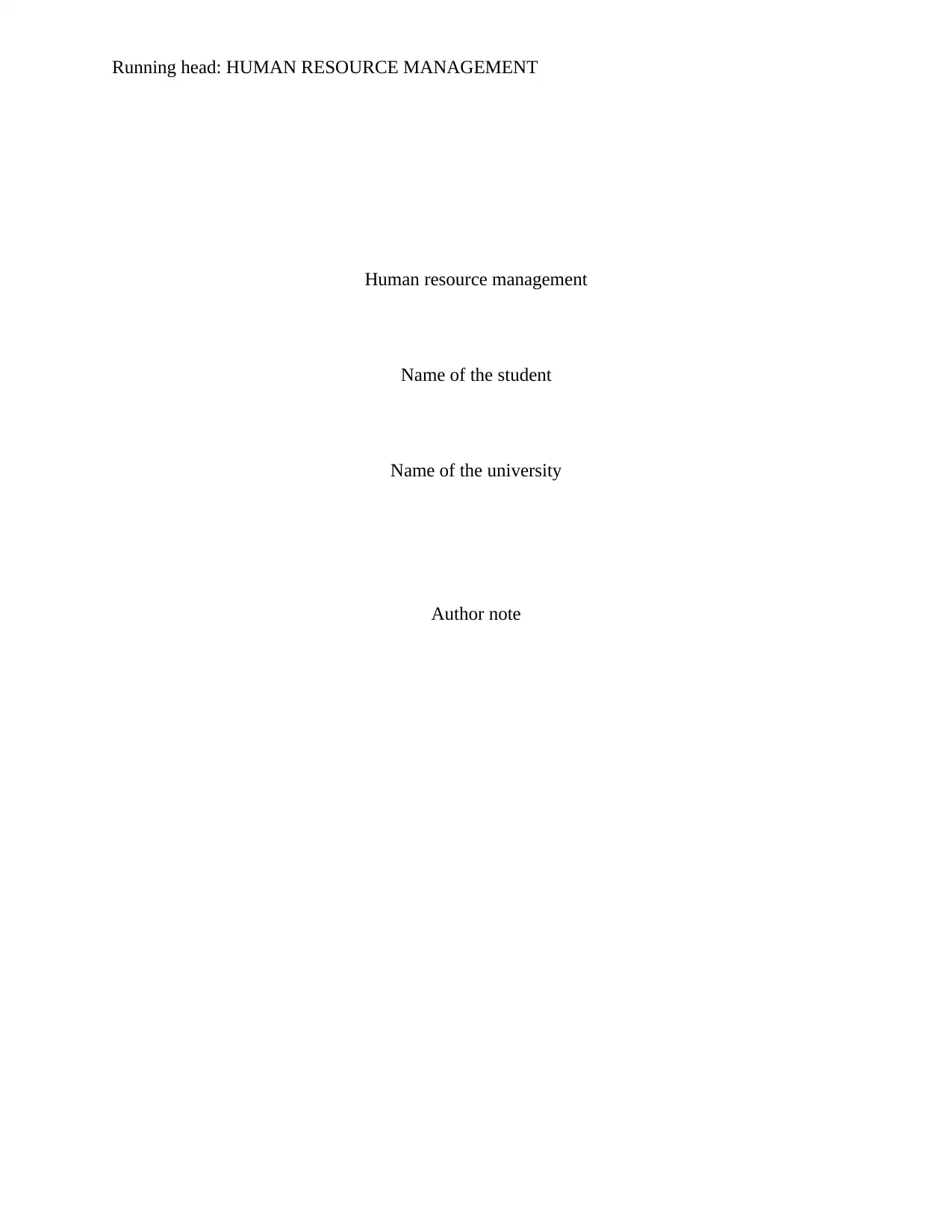
Running head: HUMAN RESOURCE MANAGEMENT
Human resource management
Name of the student
Name of the university
Author note
Human resource management
Name of the student
Name of the university
Author note
Paraphrase This Document
Need a fresh take? Get an instant paraphrase of this document with our AI Paraphraser
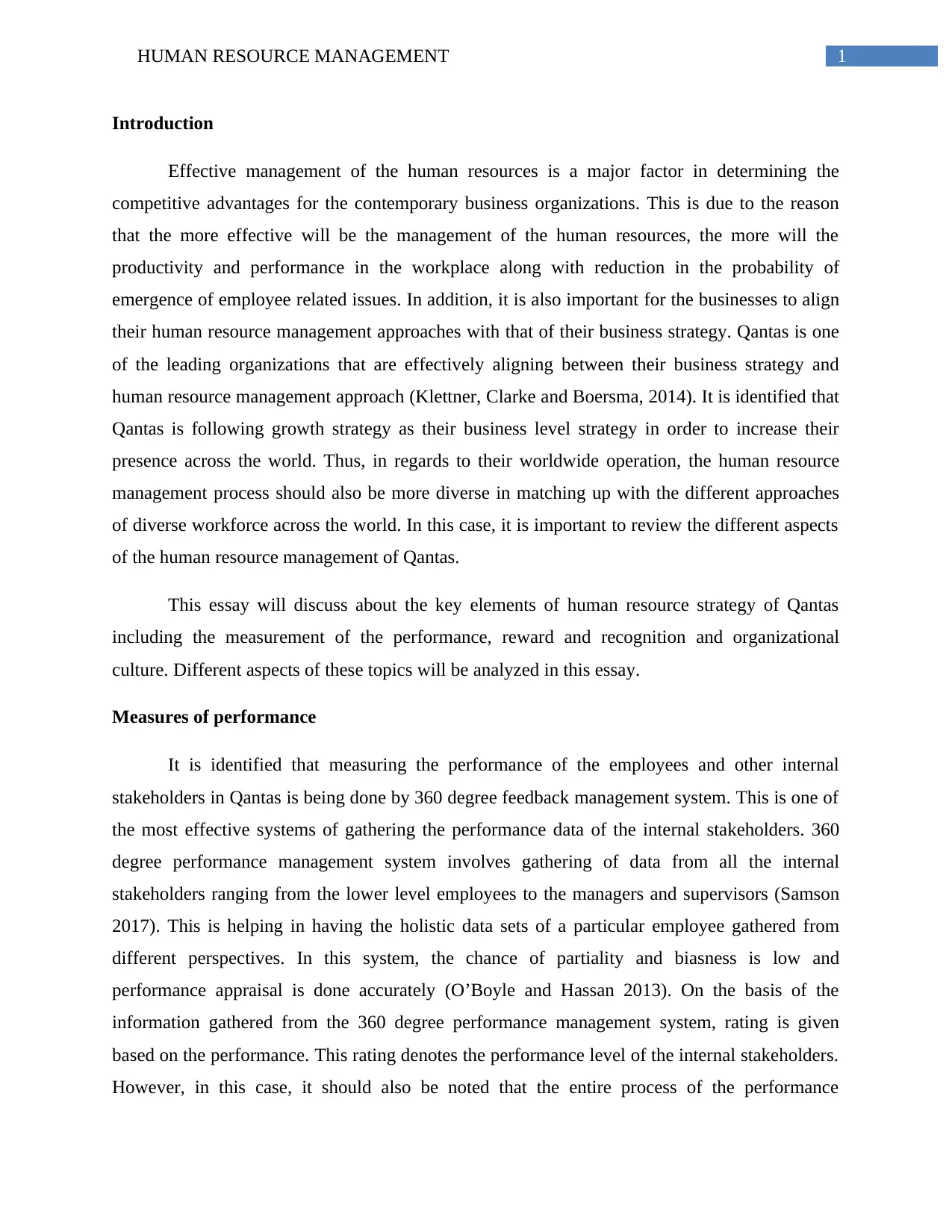
1HUMAN RESOURCE MANAGEMENT
Introduction
Effective management of the human resources is a major factor in determining the
competitive advantages for the contemporary business organizations. This is due to the reason
that the more effective will be the management of the human resources, the more will the
productivity and performance in the workplace along with reduction in the probability of
emergence of employee related issues. In addition, it is also important for the businesses to align
their human resource management approaches with that of their business strategy. Qantas is one
of the leading organizations that are effectively aligning between their business strategy and
human resource management approach (Klettner, Clarke and Boersma, 2014). It is identified that
Qantas is following growth strategy as their business level strategy in order to increase their
presence across the world. Thus, in regards to their worldwide operation, the human resource
management process should also be more diverse in matching up with the different approaches
of diverse workforce across the world. In this case, it is important to review the different aspects
of the human resource management of Qantas.
This essay will discuss about the key elements of human resource strategy of Qantas
including the measurement of the performance, reward and recognition and organizational
culture. Different aspects of these topics will be analyzed in this essay.
Measures of performance
It is identified that measuring the performance of the employees and other internal
stakeholders in Qantas is being done by 360 degree feedback management system. This is one of
the most effective systems of gathering the performance data of the internal stakeholders. 360
degree performance management system involves gathering of data from all the internal
stakeholders ranging from the lower level employees to the managers and supervisors (Samson
2017). This is helping in having the holistic data sets of a particular employee gathered from
different perspectives. In this system, the chance of partiality and biasness is low and
performance appraisal is done accurately (O’Boyle and Hassan 2013). On the basis of the
information gathered from the 360 degree performance management system, rating is given
based on the performance. This rating denotes the performance level of the internal stakeholders.
However, in this case, it should also be noted that the entire process of the performance
Introduction
Effective management of the human resources is a major factor in determining the
competitive advantages for the contemporary business organizations. This is due to the reason
that the more effective will be the management of the human resources, the more will the
productivity and performance in the workplace along with reduction in the probability of
emergence of employee related issues. In addition, it is also important for the businesses to align
their human resource management approaches with that of their business strategy. Qantas is one
of the leading organizations that are effectively aligning between their business strategy and
human resource management approach (Klettner, Clarke and Boersma, 2014). It is identified that
Qantas is following growth strategy as their business level strategy in order to increase their
presence across the world. Thus, in regards to their worldwide operation, the human resource
management process should also be more diverse in matching up with the different approaches
of diverse workforce across the world. In this case, it is important to review the different aspects
of the human resource management of Qantas.
This essay will discuss about the key elements of human resource strategy of Qantas
including the measurement of the performance, reward and recognition and organizational
culture. Different aspects of these topics will be analyzed in this essay.
Measures of performance
It is identified that measuring the performance of the employees and other internal
stakeholders in Qantas is being done by 360 degree feedback management system. This is one of
the most effective systems of gathering the performance data of the internal stakeholders. 360
degree performance management system involves gathering of data from all the internal
stakeholders ranging from the lower level employees to the managers and supervisors (Samson
2017). This is helping in having the holistic data sets of a particular employee gathered from
different perspectives. In this system, the chance of partiality and biasness is low and
performance appraisal is done accurately (O’Boyle and Hassan 2013). On the basis of the
information gathered from the 360 degree performance management system, rating is given
based on the performance. This rating denotes the performance level of the internal stakeholders.
However, in this case, it should also be noted that the entire process of the performance
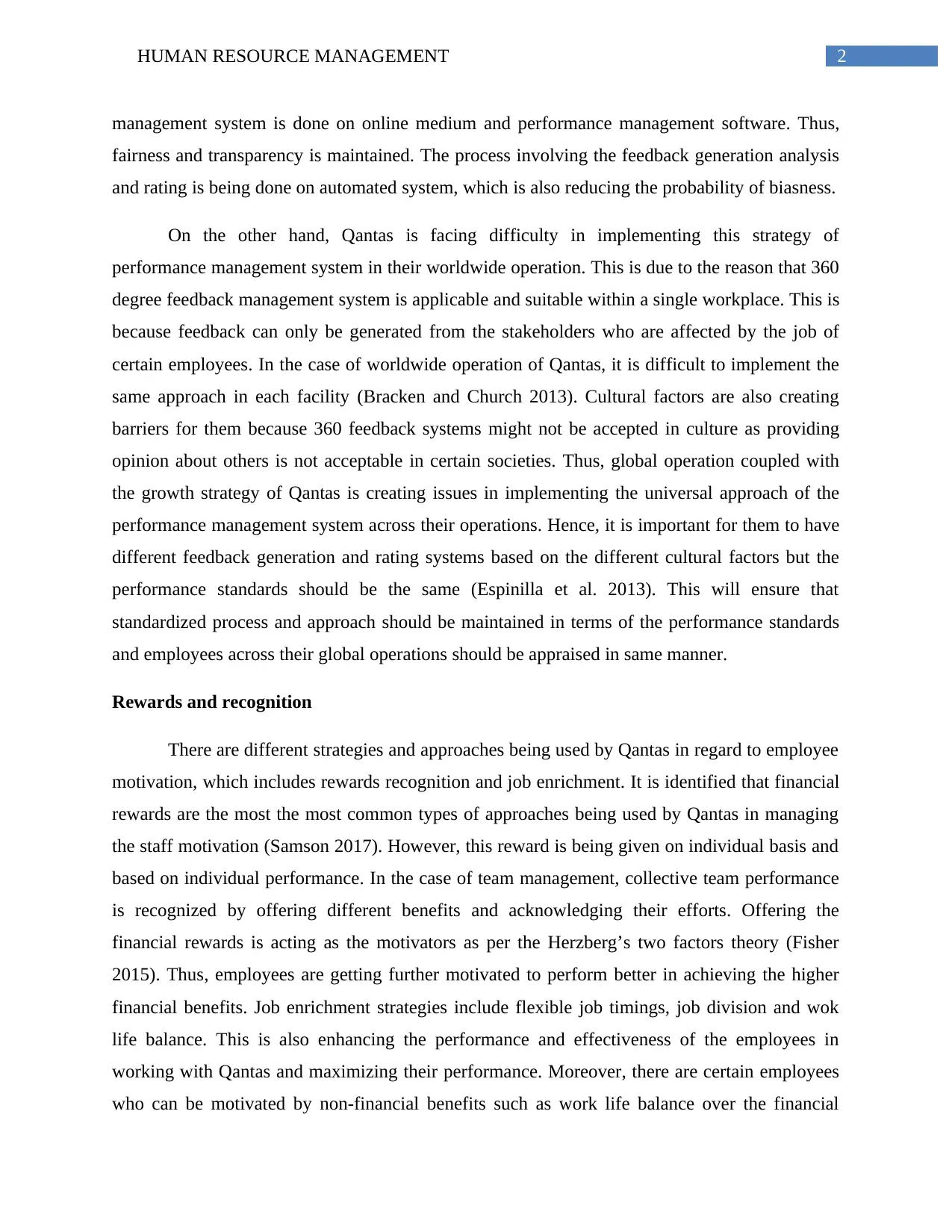
2HUMAN RESOURCE MANAGEMENT
management system is done on online medium and performance management software. Thus,
fairness and transparency is maintained. The process involving the feedback generation analysis
and rating is being done on automated system, which is also reducing the probability of biasness.
On the other hand, Qantas is facing difficulty in implementing this strategy of
performance management system in their worldwide operation. This is due to the reason that 360
degree feedback management system is applicable and suitable within a single workplace. This is
because feedback can only be generated from the stakeholders who are affected by the job of
certain employees. In the case of worldwide operation of Qantas, it is difficult to implement the
same approach in each facility (Bracken and Church 2013). Cultural factors are also creating
barriers for them because 360 feedback systems might not be accepted in culture as providing
opinion about others is not acceptable in certain societies. Thus, global operation coupled with
the growth strategy of Qantas is creating issues in implementing the universal approach of the
performance management system across their operations. Hence, it is important for them to have
different feedback generation and rating systems based on the different cultural factors but the
performance standards should be the same (Espinilla et al. 2013). This will ensure that
standardized process and approach should be maintained in terms of the performance standards
and employees across their global operations should be appraised in same manner.
Rewards and recognition
There are different strategies and approaches being used by Qantas in regard to employee
motivation, which includes rewards recognition and job enrichment. It is identified that financial
rewards are the most the most common types of approaches being used by Qantas in managing
the staff motivation (Samson 2017). However, this reward is being given on individual basis and
based on individual performance. In the case of team management, collective team performance
is recognized by offering different benefits and acknowledging their efforts. Offering the
financial rewards is acting as the motivators as per the Herzberg’s two factors theory (Fisher
2015). Thus, employees are getting further motivated to perform better in achieving the higher
financial benefits. Job enrichment strategies include flexible job timings, job division and wok
life balance. This is also enhancing the performance and effectiveness of the employees in
working with Qantas and maximizing their performance. Moreover, there are certain employees
who can be motivated by non-financial benefits such as work life balance over the financial
management system is done on online medium and performance management software. Thus,
fairness and transparency is maintained. The process involving the feedback generation analysis
and rating is being done on automated system, which is also reducing the probability of biasness.
On the other hand, Qantas is facing difficulty in implementing this strategy of
performance management system in their worldwide operation. This is due to the reason that 360
degree feedback management system is applicable and suitable within a single workplace. This is
because feedback can only be generated from the stakeholders who are affected by the job of
certain employees. In the case of worldwide operation of Qantas, it is difficult to implement the
same approach in each facility (Bracken and Church 2013). Cultural factors are also creating
barriers for them because 360 feedback systems might not be accepted in culture as providing
opinion about others is not acceptable in certain societies. Thus, global operation coupled with
the growth strategy of Qantas is creating issues in implementing the universal approach of the
performance management system across their operations. Hence, it is important for them to have
different feedback generation and rating systems based on the different cultural factors but the
performance standards should be the same (Espinilla et al. 2013). This will ensure that
standardized process and approach should be maintained in terms of the performance standards
and employees across their global operations should be appraised in same manner.
Rewards and recognition
There are different strategies and approaches being used by Qantas in regard to employee
motivation, which includes rewards recognition and job enrichment. It is identified that financial
rewards are the most the most common types of approaches being used by Qantas in managing
the staff motivation (Samson 2017). However, this reward is being given on individual basis and
based on individual performance. In the case of team management, collective team performance
is recognized by offering different benefits and acknowledging their efforts. Offering the
financial rewards is acting as the motivators as per the Herzberg’s two factors theory (Fisher
2015). Thus, employees are getting further motivated to perform better in achieving the higher
financial benefits. Job enrichment strategies include flexible job timings, job division and wok
life balance. This is also enhancing the performance and effectiveness of the employees in
working with Qantas and maximizing their performance. Moreover, there are certain employees
who can be motivated by non-financial benefits such as work life balance over the financial
⊘ This is a preview!⊘
Do you want full access?
Subscribe today to unlock all pages.

Trusted by 1+ million students worldwide
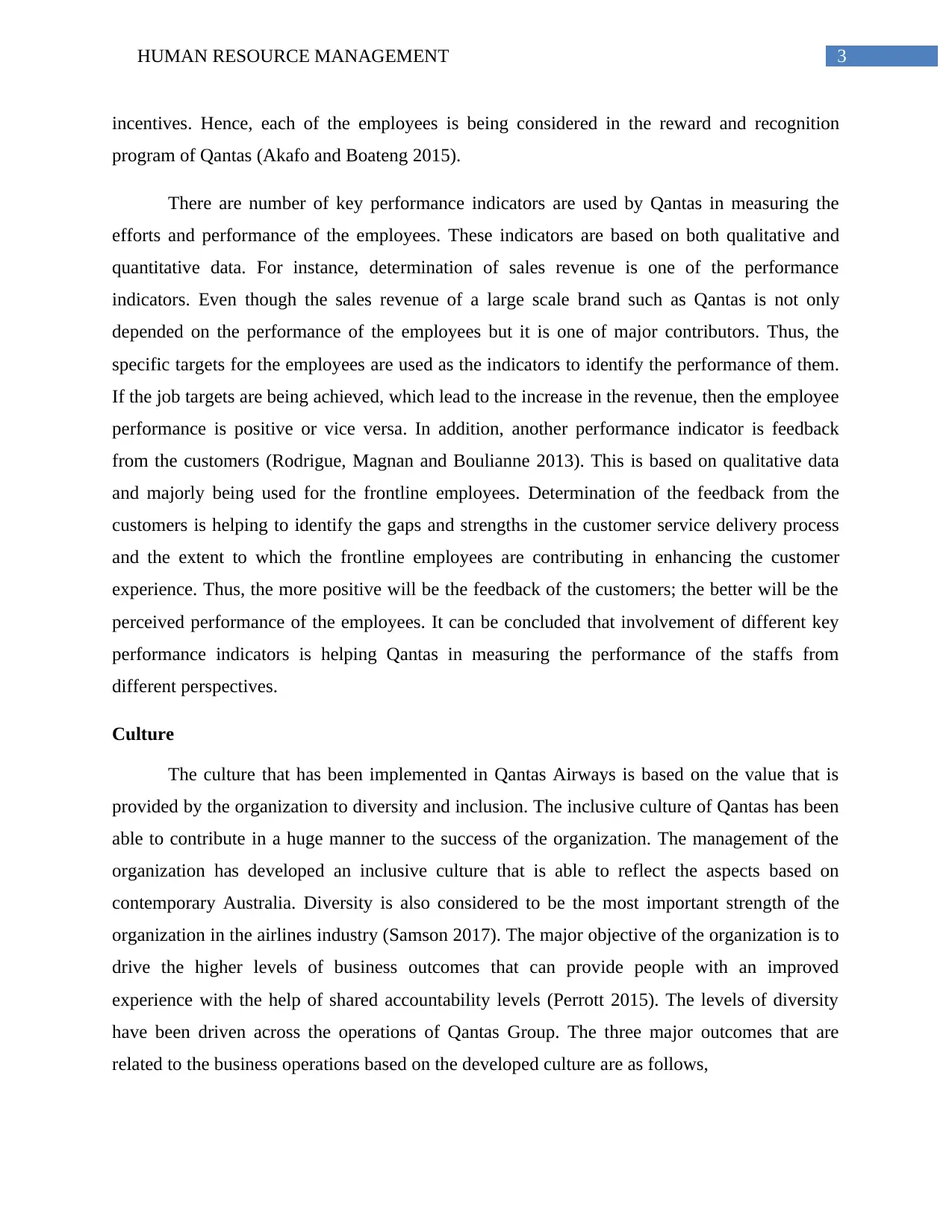
3HUMAN RESOURCE MANAGEMENT
incentives. Hence, each of the employees is being considered in the reward and recognition
program of Qantas (Akafo and Boateng 2015).
There are number of key performance indicators are used by Qantas in measuring the
efforts and performance of the employees. These indicators are based on both qualitative and
quantitative data. For instance, determination of sales revenue is one of the performance
indicators. Even though the sales revenue of a large scale brand such as Qantas is not only
depended on the performance of the employees but it is one of major contributors. Thus, the
specific targets for the employees are used as the indicators to identify the performance of them.
If the job targets are being achieved, which lead to the increase in the revenue, then the employee
performance is positive or vice versa. In addition, another performance indicator is feedback
from the customers (Rodrigue, Magnan and Boulianne 2013). This is based on qualitative data
and majorly being used for the frontline employees. Determination of the feedback from the
customers is helping to identify the gaps and strengths in the customer service delivery process
and the extent to which the frontline employees are contributing in enhancing the customer
experience. Thus, the more positive will be the feedback of the customers; the better will be the
perceived performance of the employees. It can be concluded that involvement of different key
performance indicators is helping Qantas in measuring the performance of the staffs from
different perspectives.
Culture
The culture that has been implemented in Qantas Airways is based on the value that is
provided by the organization to diversity and inclusion. The inclusive culture of Qantas has been
able to contribute in a huge manner to the success of the organization. The management of the
organization has developed an inclusive culture that is able to reflect the aspects based on
contemporary Australia. Diversity is also considered to be the most important strength of the
organization in the airlines industry (Samson 2017). The major objective of the organization is to
drive the higher levels of business outcomes that can provide people with an improved
experience with the help of shared accountability levels (Perrott 2015). The levels of diversity
have been driven across the operations of Qantas Group. The three major outcomes that are
related to the business operations based on the developed culture are as follows,
incentives. Hence, each of the employees is being considered in the reward and recognition
program of Qantas (Akafo and Boateng 2015).
There are number of key performance indicators are used by Qantas in measuring the
efforts and performance of the employees. These indicators are based on both qualitative and
quantitative data. For instance, determination of sales revenue is one of the performance
indicators. Even though the sales revenue of a large scale brand such as Qantas is not only
depended on the performance of the employees but it is one of major contributors. Thus, the
specific targets for the employees are used as the indicators to identify the performance of them.
If the job targets are being achieved, which lead to the increase in the revenue, then the employee
performance is positive or vice versa. In addition, another performance indicator is feedback
from the customers (Rodrigue, Magnan and Boulianne 2013). This is based on qualitative data
and majorly being used for the frontline employees. Determination of the feedback from the
customers is helping to identify the gaps and strengths in the customer service delivery process
and the extent to which the frontline employees are contributing in enhancing the customer
experience. Thus, the more positive will be the feedback of the customers; the better will be the
perceived performance of the employees. It can be concluded that involvement of different key
performance indicators is helping Qantas in measuring the performance of the staffs from
different perspectives.
Culture
The culture that has been implemented in Qantas Airways is based on the value that is
provided by the organization to diversity and inclusion. The inclusive culture of Qantas has been
able to contribute in a huge manner to the success of the organization. The management of the
organization has developed an inclusive culture that is able to reflect the aspects based on
contemporary Australia. Diversity is also considered to be the most important strength of the
organization in the airlines industry (Samson 2017). The major objective of the organization is to
drive the higher levels of business outcomes that can provide people with an improved
experience with the help of shared accountability levels (Perrott 2015). The levels of diversity
have been driven across the operations of Qantas Group. The three major outcomes that are
related to the business operations based on the developed culture are as follows,
Paraphrase This Document
Need a fresh take? Get an instant paraphrase of this document with our AI Paraphraser
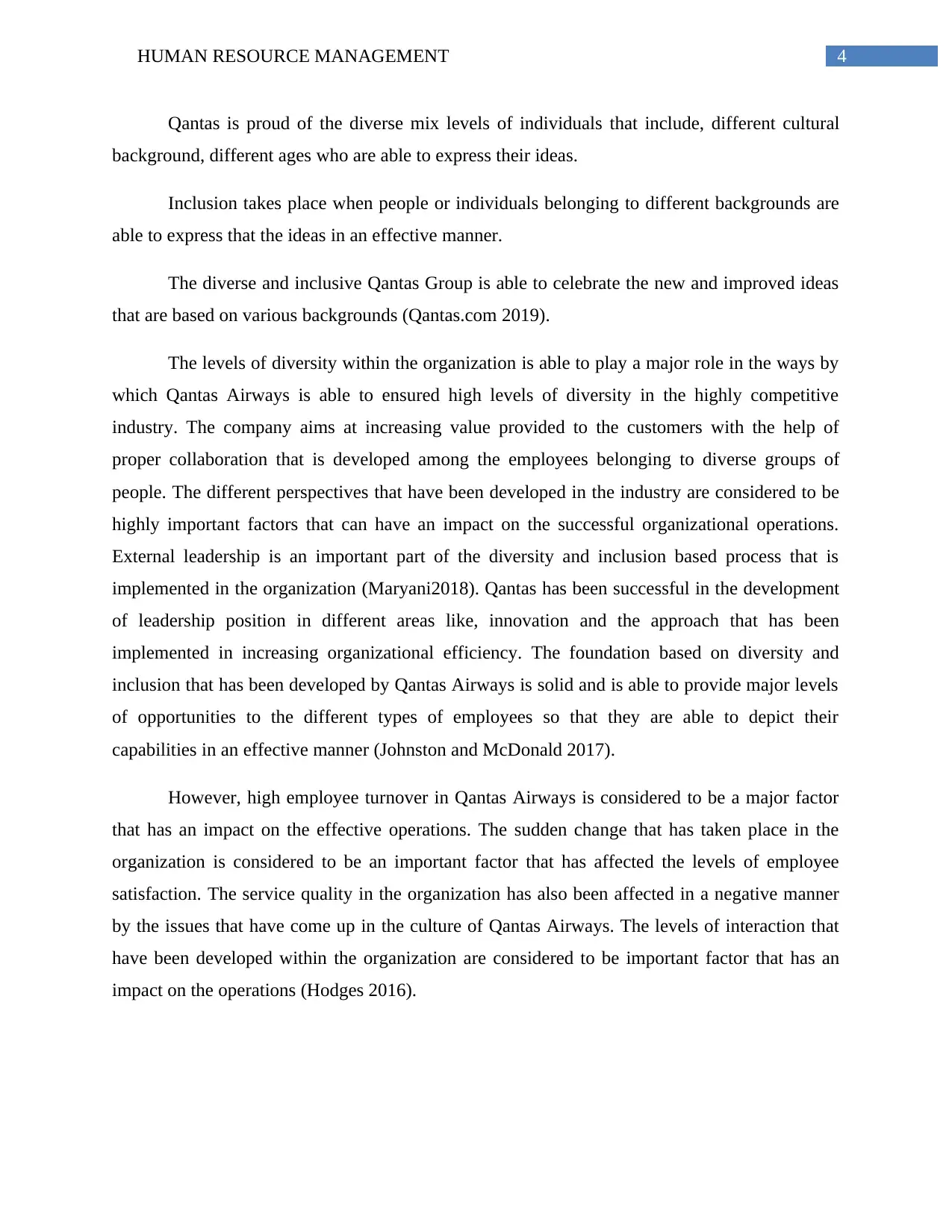
4HUMAN RESOURCE MANAGEMENT
Qantas is proud of the diverse mix levels of individuals that include, different cultural
background, different ages who are able to express their ideas.
Inclusion takes place when people or individuals belonging to different backgrounds are
able to express that the ideas in an effective manner.
The diverse and inclusive Qantas Group is able to celebrate the new and improved ideas
that are based on various backgrounds (Qantas.com 2019).
The levels of diversity within the organization is able to play a major role in the ways by
which Qantas Airways is able to ensured high levels of diversity in the highly competitive
industry. The company aims at increasing value provided to the customers with the help of
proper collaboration that is developed among the employees belonging to diverse groups of
people. The different perspectives that have been developed in the industry are considered to be
highly important factors that can have an impact on the successful organizational operations.
External leadership is an important part of the diversity and inclusion based process that is
implemented in the organization (Maryani2018). Qantas has been successful in the development
of leadership position in different areas like, innovation and the approach that has been
implemented in increasing organizational efficiency. The foundation based on diversity and
inclusion that has been developed by Qantas Airways is solid and is able to provide major levels
of opportunities to the different types of employees so that they are able to depict their
capabilities in an effective manner (Johnston and McDonald 2017).
However, high employee turnover in Qantas Airways is considered to be a major factor
that has an impact on the effective operations. The sudden change that has taken place in the
organization is considered to be an important factor that has affected the levels of employee
satisfaction. The service quality in the organization has also been affected in a negative manner
by the issues that have come up in the culture of Qantas Airways. The levels of interaction that
have been developed within the organization are considered to be important factor that has an
impact on the operations (Hodges 2016).
Qantas is proud of the diverse mix levels of individuals that include, different cultural
background, different ages who are able to express their ideas.
Inclusion takes place when people or individuals belonging to different backgrounds are
able to express that the ideas in an effective manner.
The diverse and inclusive Qantas Group is able to celebrate the new and improved ideas
that are based on various backgrounds (Qantas.com 2019).
The levels of diversity within the organization is able to play a major role in the ways by
which Qantas Airways is able to ensured high levels of diversity in the highly competitive
industry. The company aims at increasing value provided to the customers with the help of
proper collaboration that is developed among the employees belonging to diverse groups of
people. The different perspectives that have been developed in the industry are considered to be
highly important factors that can have an impact on the successful organizational operations.
External leadership is an important part of the diversity and inclusion based process that is
implemented in the organization (Maryani2018). Qantas has been successful in the development
of leadership position in different areas like, innovation and the approach that has been
implemented in increasing organizational efficiency. The foundation based on diversity and
inclusion that has been developed by Qantas Airways is solid and is able to provide major levels
of opportunities to the different types of employees so that they are able to depict their
capabilities in an effective manner (Johnston and McDonald 2017).
However, high employee turnover in Qantas Airways is considered to be a major factor
that has an impact on the effective operations. The sudden change that has taken place in the
organization is considered to be an important factor that has affected the levels of employee
satisfaction. The service quality in the organization has also been affected in a negative manner
by the issues that have come up in the culture of Qantas Airways. The levels of interaction that
have been developed within the organization are considered to be important factor that has an
impact on the operations (Hodges 2016).
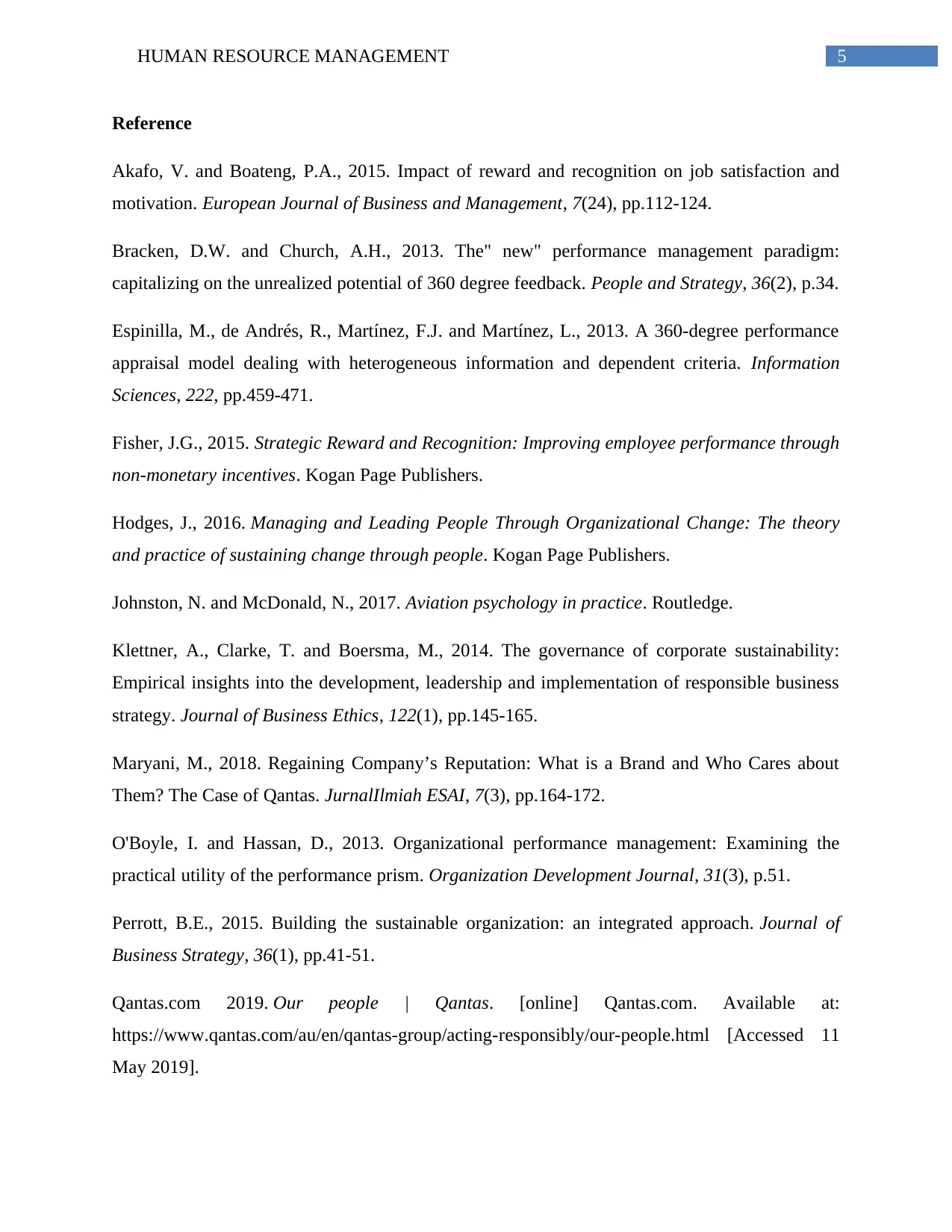
5HUMAN RESOURCE MANAGEMENT
Reference
Akafo, V. and Boateng, P.A., 2015. Impact of reward and recognition on job satisfaction and
motivation. European Journal of Business and Management, 7(24), pp.112-124.
Bracken, D.W. and Church, A.H., 2013. The" new" performance management paradigm:
capitalizing on the unrealized potential of 360 degree feedback. People and Strategy, 36(2), p.34.
Espinilla, M., de Andrés, R., Martínez, F.J. and Martínez, L., 2013. A 360-degree performance
appraisal model dealing with heterogeneous information and dependent criteria. Information
Sciences, 222, pp.459-471.
Fisher, J.G., 2015. Strategic Reward and Recognition: Improving employee performance through
non-monetary incentives. Kogan Page Publishers.
Hodges, J., 2016. Managing and Leading People Through Organizational Change: The theory
and practice of sustaining change through people. Kogan Page Publishers.
Johnston, N. and McDonald, N., 2017. Aviation psychology in practice. Routledge.
Klettner, A., Clarke, T. and Boersma, M., 2014. The governance of corporate sustainability:
Empirical insights into the development, leadership and implementation of responsible business
strategy. Journal of Business Ethics, 122(1), pp.145-165.
Maryani, M., 2018. Regaining Company’s Reputation: What is a Brand and Who Cares about
Them? The Case of Qantas. JurnalIlmiah ESAI, 7(3), pp.164-172.
O'Boyle, I. and Hassan, D., 2013. Organizational performance management: Examining the
practical utility of the performance prism. Organization Development Journal, 31(3), p.51.
Perrott, B.E., 2015. Building the sustainable organization: an integrated approach. Journal of
Business Strategy, 36(1), pp.41-51.
Qantas.com 2019. Our people | Qantas. [online] Qantas.com. Available at:
https://www.qantas.com/au/en/qantas-group/acting-responsibly/our-people.html [Accessed 11
May 2019].
Reference
Akafo, V. and Boateng, P.A., 2015. Impact of reward and recognition on job satisfaction and
motivation. European Journal of Business and Management, 7(24), pp.112-124.
Bracken, D.W. and Church, A.H., 2013. The" new" performance management paradigm:
capitalizing on the unrealized potential of 360 degree feedback. People and Strategy, 36(2), p.34.
Espinilla, M., de Andrés, R., Martínez, F.J. and Martínez, L., 2013. A 360-degree performance
appraisal model dealing with heterogeneous information and dependent criteria. Information
Sciences, 222, pp.459-471.
Fisher, J.G., 2015. Strategic Reward and Recognition: Improving employee performance through
non-monetary incentives. Kogan Page Publishers.
Hodges, J., 2016. Managing and Leading People Through Organizational Change: The theory
and practice of sustaining change through people. Kogan Page Publishers.
Johnston, N. and McDonald, N., 2017. Aviation psychology in practice. Routledge.
Klettner, A., Clarke, T. and Boersma, M., 2014. The governance of corporate sustainability:
Empirical insights into the development, leadership and implementation of responsible business
strategy. Journal of Business Ethics, 122(1), pp.145-165.
Maryani, M., 2018. Regaining Company’s Reputation: What is a Brand and Who Cares about
Them? The Case of Qantas. JurnalIlmiah ESAI, 7(3), pp.164-172.
O'Boyle, I. and Hassan, D., 2013. Organizational performance management: Examining the
practical utility of the performance prism. Organization Development Journal, 31(3), p.51.
Perrott, B.E., 2015. Building the sustainable organization: an integrated approach. Journal of
Business Strategy, 36(1), pp.41-51.
Qantas.com 2019. Our people | Qantas. [online] Qantas.com. Available at:
https://www.qantas.com/au/en/qantas-group/acting-responsibly/our-people.html [Accessed 11
May 2019].
⊘ This is a preview!⊘
Do you want full access?
Subscribe today to unlock all pages.

Trusted by 1+ million students worldwide
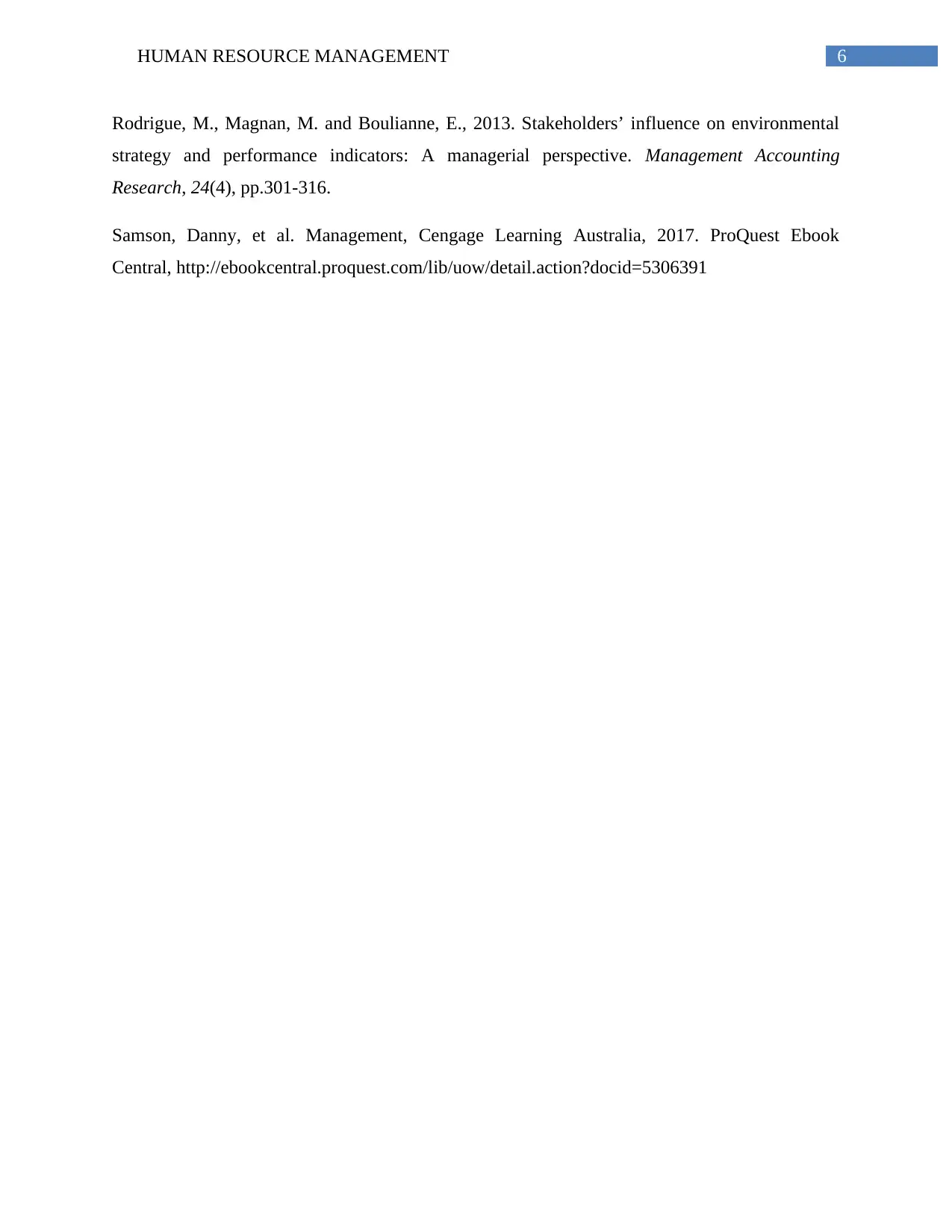
6HUMAN RESOURCE MANAGEMENT
Rodrigue, M., Magnan, M. and Boulianne, E., 2013. Stakeholders’ influence on environmental
strategy and performance indicators: A managerial perspective. Management Accounting
Research, 24(4), pp.301-316.
Samson, Danny, et al. Management, Cengage Learning Australia, 2017. ProQuest Ebook
Central, http://ebookcentral.proquest.com/lib/uow/detail.action?docid=5306391
Rodrigue, M., Magnan, M. and Boulianne, E., 2013. Stakeholders’ influence on environmental
strategy and performance indicators: A managerial perspective. Management Accounting
Research, 24(4), pp.301-316.
Samson, Danny, et al. Management, Cengage Learning Australia, 2017. ProQuest Ebook
Central, http://ebookcentral.proquest.com/lib/uow/detail.action?docid=5306391
1 out of 7
Related Documents
Your All-in-One AI-Powered Toolkit for Academic Success.
+13062052269
info@desklib.com
Available 24*7 on WhatsApp / Email
![[object Object]](/_next/static/media/star-bottom.7253800d.svg)
Unlock your academic potential
Copyright © 2020–2025 A2Z Services. All Rights Reserved. Developed and managed by ZUCOL.





